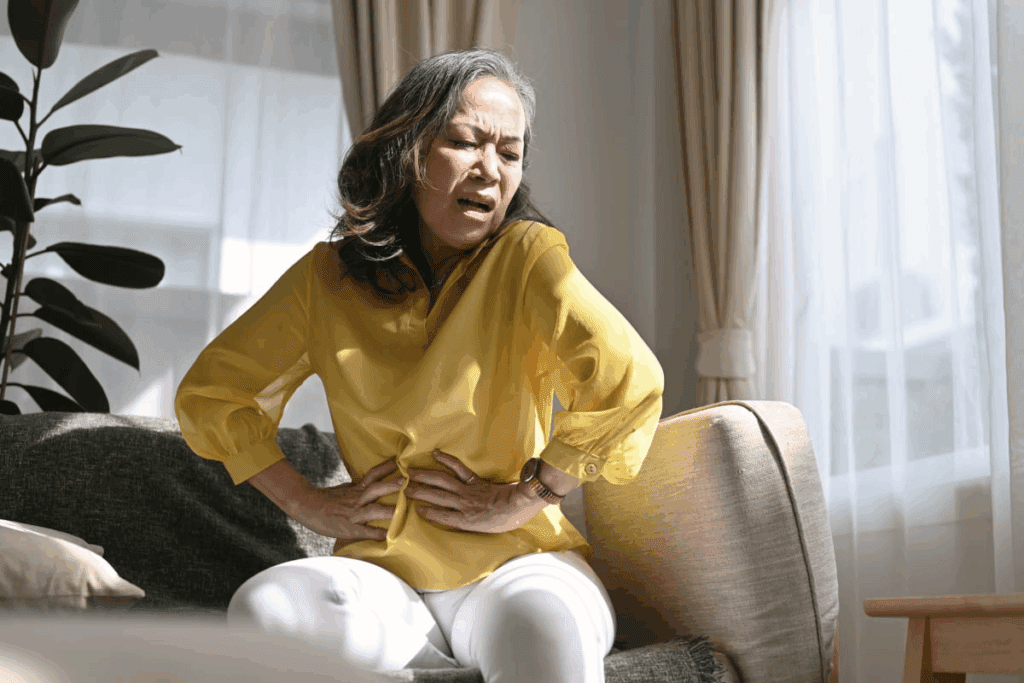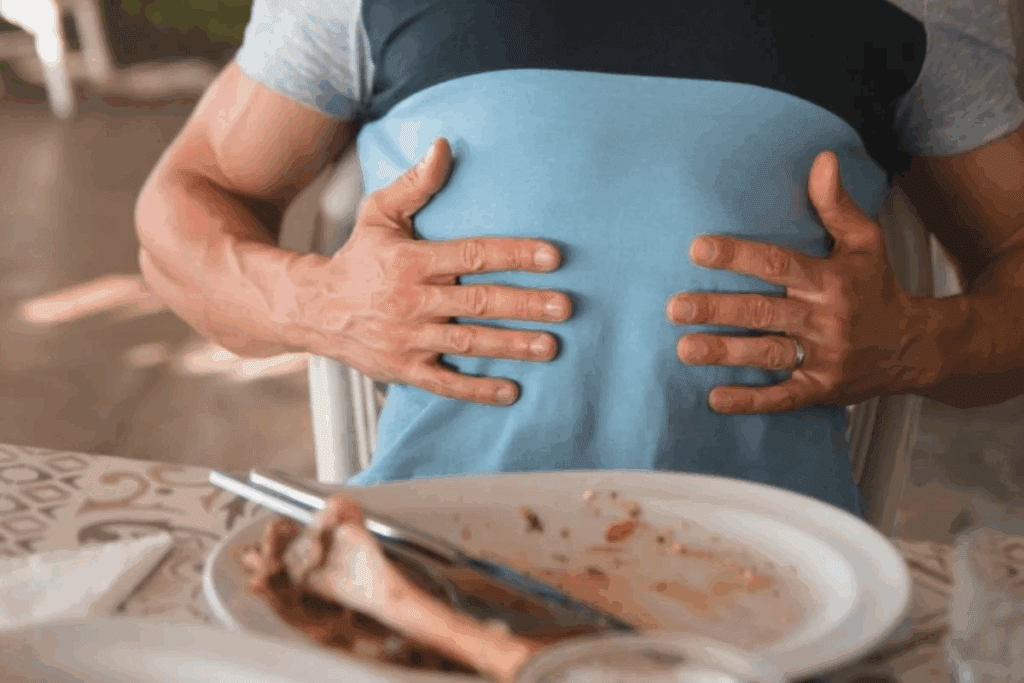Last Updated on November 26, 2025 by Bilal Hasdemir

Feeling stuck with digestive issues can be really worrying. You might wonder if your gallbladder is the problem. The gallbladder is key to digestion, and issues with it can cause big health problems.
Pain in the mid to upper-right part of your belly might mean you have a gallbladder problem. While you usually need a doctor to figure out gallbladder issues, there are some things you can check at home.
It’s important to know how your gallbladder works and what common problems look like. If you keep feeling bad, it’s key to know when to go see a doctor.

The gallbladder plays a key role in digestion by storing bile. This fluid is essential for breaking down fats and vitamins. Knowing how to check gallbladder function is important for your health.
The gallbladder stores and concentrates bile, a yellow-green fluid from the liver. Bile helps break down fats and vitamins in our food. When we eat fatty foods, the gallbladder releases bile into the small intestine.
Bile Storage and Release Mechanism
Gallbladder issues are common and can include gallstones, inflammation, and dysfunction. Knowing about these problems helps in early detection and treatment.
| Condition | Description | Common Symptoms |
| Gallstones | Hardened deposits in the gallbladder. | Severe abdominal pain, nausea. |
| Cholecystitis | Inflammation of the gallbladder. | Pain in the upper right abdomen, fever. |
| Gallbladder Dysfunction | Impaired gallbladder function. | Bloating, indigestion, fatty food intolerance. |
Recognizing symptoms early is key to getting the right medical care. If you have persistent or severe symptoms, see a doctor. They can diagnose and treat your condition.

It’s important to know the signs of gallbladder disease to get help quickly. The gallbladder helps with digestion. Problems with it can show up in different ways.
Pain in the upper right abdomen is a common sign of gallbladder trouble. This pain might be steady or get worse with fatty foods. Pay attention to how often and how bad the pain is.
Table 1: Common Pain Patterns Associated with Gallbladder Issues
| Pain Characteristic | Description |
| Location | Upper right abdomen |
| Radiation | Right shoulder or back |
| Trigger | Fatty meals |
Digestive problems can also point to gallbladder issues. Look out for:
There are other signs that might mean you have gallbladder problems. These include:
Spotting these symptoms early is key. If you notice any, see a doctor right away. They can help figure out what’s wrong and how to fix it.
There are home tests to check for gallbladder problems. These tests aren’t perfect but can give you clues about your gallbladder health.
Murphy’s Sign is a simple test to check for gallbladder issues. Here’s how to do it:
Murphy’s Sign is not foolproof. It should be used with other symptoms and tests.
Keeping a food diary and tracking symptoms can help. Record the foods you eat and any symptoms like pain or digestive issues.
This can show you which foods might cause gallbladder problems. Foods high in fat or grease are common culprits.
There are urine tests you can buy to check gallbladder function. These tests look for certain compounds in your urine that might show gallbladder problems.
But, these tests might not always be reliable or accurate. It’s important to follow the instructions and think about your symptoms when you get the results.
Remember, home tests for gallbladder issues aren’t a replacement for a doctor’s diagnosis. If you have ongoing or severe symptoms, see a healthcare professional for the right care.
Dietary tests are a practical way to check gallbladder health. They involve changing your diet and watching how your body reacts, mainly to fats.
The fat challenge test is easy to do at home. It involves eating a lot of fat and seeing how your body reacts. A high-fat meal usually makes the gallbladder contract and release bile. If your gallbladder works right, you won’t feel much pain. But if it doesn’t, you might feel pain or discomfort in your upper right side.
To do the fat challenge test at home:
Tracking food sensitivities is another way to check your gallbladder. Some foods can make your gallbladder contract. Keeping a food diary helps you see which foods might be causing problems.
To track food sensitivities:
Dietary tests can give useful insights but have their limits. They’re not perfect for diagnosing gallbladder issues. For a reliable diagnosis, you need a doctor’s evaluation and possibly more tests.
It’s best to use dietary tests with your doctor’s advice. If you have ongoing or severe symptoms, see a healthcare professional for a full check-up.
You can check your gallbladder health at home with simple techniques. These methods can give you clues about gallbladder problems. They help you know if you need to see a doctor.
Palpation means feeling your abdomen to find tender spots or abnormalities. Here’s how to do a self-check:
Tenderness in this area may indicate gallbladder inflammation or other issues.
Certain postures and movements can make gallbladder pain worse. This can give you clues about its health:
Applying heat or cold to your abdomen can help identify gallbladder issues:
The following table summarizes the physical examination techniques discussed:
| Technique | Description | Potential Indication |
| Palpation | Feeling the abdomen for tenderness | Gallbladder inflammation or mass |
| Posture and Movement Tests | Assessing pain with movement or posture | Gallbladder disease or pain |
| Temperature Sensitivity | Applying heat or cold to the abdomen | Gallbladder issues or inflammation |
At-home gallbladder tests are useful but have limits and risks. They give initial insights into gallbladder health. But, they can’t replace a full medical check-up.
Self-testing at home can be tricky because gallbladder diseases are complex. Gallbladder problems often show symptoms that are not clear and can be mistaken for other issues. So, getting a doctor’s opinion is key.
The results of at-home tests can be affected by many things. This includes how well the person understands the results and the test’s accuracy. Without medical training, people might not understand their results correctly. This can cause delays in getting the right treatment.
Choosing to wait for professional care instead of using at-home tests can harm your health. Not treating gallbladder disease can cause serious problems like gallstone pancreatitis or cholecystitis. These need quick medical help.
Dependence on at-home tests can make people feel safe when they’re not. If symptoms don’t get better or get worse, it’s important to see a doctor. Don’t keep relying on self-testing.
Any results from at-home tests need a doctor’s check. Doctors can do a detailed check and more tests to see if there’s gallbladder disease.
Getting a doctor’s approval is vital for the right treatment plan. Doctors make sure any problems are found and treated right. This helps avoid serious issues and improves health outcomes.
Healthcare experts use advanced tests to find gallstones and gallbladder issues. These tests help them figure out the right treatment.
Ultrasound is a key tool for checking the gallbladder. It’s safe and good at spotting gallstones and other problems. Ultrasound imaging uses sound waves to see inside the gallbladder.
Blood tests help check the gallbladder and liver. They look for signs of disease. Tests like liver function tests and complete blood counts are common.
| Blood Test | Purpose |
| Liver Function Tests | Assess liver damage or disease |
| Complete Blood Count (CBC) | Check for signs of infection or inflammation |
| Bilirubin Test | Measure levels of bilirubin in the blood |
A HIDA scan checks the gallbladder and bile ducts. It uses a tiny bit of radioactive material. This material is absorbed by the liver and then goes into the bile.
Other tests like CT scans, MRI, and endoscopic ultrasound give detailed pictures. They help find and treat complex problems.
Endoscopic procedures, like ERCP, use a camera and tools to look at the bile ducts and gallbladder. ERCP can diagnose and treat some gallbladder and bile duct issues.
These tests are vital for finding and treating gallbladder problems. They help doctors create the best treatment plan.
Knowing when to see a doctor for gallbladder problems is key to avoiding serious issues. The gallbladder is vital for digestion. Problems with it can cause severe health problems if not treated quickly.
Certain symptoms mean you need to see a doctor right away. These include:
If you have these symptoms, go to the emergency room. Waiting too long can cause serious problems, like gangrene or a perforated gallbladder.
Some symptoms are not urgent but should get you to the doctor. These include:
These signs might mean your gallbladder isn’t working right or there’s another issue that needs a doctor’s check-up.
Before your doctor’s visit, do the following:
Being ready for your appointment helps you get the best care and make smart choices about your treatment.
At-home tests can help spot gallbladder issues, but they need to be used with professional medical care. This balance is key to keeping your gallbladder healthy.
Tests like Murphy’s Sign and dietary tests offer insights into your gallbladder. Yet, they have their limits. They shouldn’t be the only way to figure out what’s wrong.
Seeing a doctor is vital to confirm what at-home tests show. Doctors can do detailed tests like ultrasound and HIDA scans. These help find out if there’s a problem with your gallbladder.
Using both at-home tests and doctor visits helps you stay on top of your gallbladder health. This way, you can make smart choices about your health. And you’ll know when to see a doctor.
The gallbladder stores bile from the liver. It releases bile into the small intestine. This helps with fat digestion and absorbing fat-soluble vitamins.
You can do a fat challenge test at home. This involves eating a high-fat meal and watching for symptoms. You can also track food sensitivities and do physical tests like palpation.
Symptoms include pain in the upper right abdomen. You might also feel nausea, bloating, fever, and jaundice.
No, you can’t diagnose gallbladder problems by yourself. While home tests can give clues, a doctor’s evaluation is needed for a correct diagnosis and treatment.
Home tests might not always be accurate. They can miss some conditions. This is why you need a doctor’s confirmation.
Doctors use ultrasound and blood tests to check liver and gallbladder function. They also do HIDA scans and endoscopic procedures for diagnosis.
Get immediate care for severe pain, fever, and jaundice. For other symptoms, make an appointment with your doctor.
Write down your symptoms, medical history, and any home test results. This will help you discuss your situation with your doctor.
Yes, changing your diet can help. Avoid fatty foods and watch for food sensitivities. But, always talk to your doctor first for advice.
The fat challenge test involves eating a high-fat meal. Then, watch for pain or discomfort. This can show how your gallbladder is working.
The reliability of these tests can vary. It’s best to use caution and talk to a healthcare professional about the results.
Subscribe to our e-newsletter to stay informed about the latest innovations in the world of health and exclusive offers!